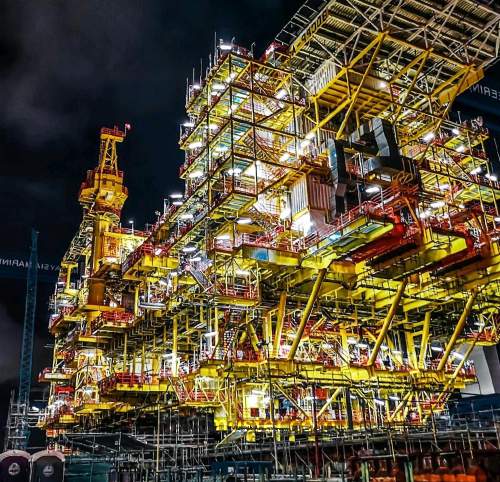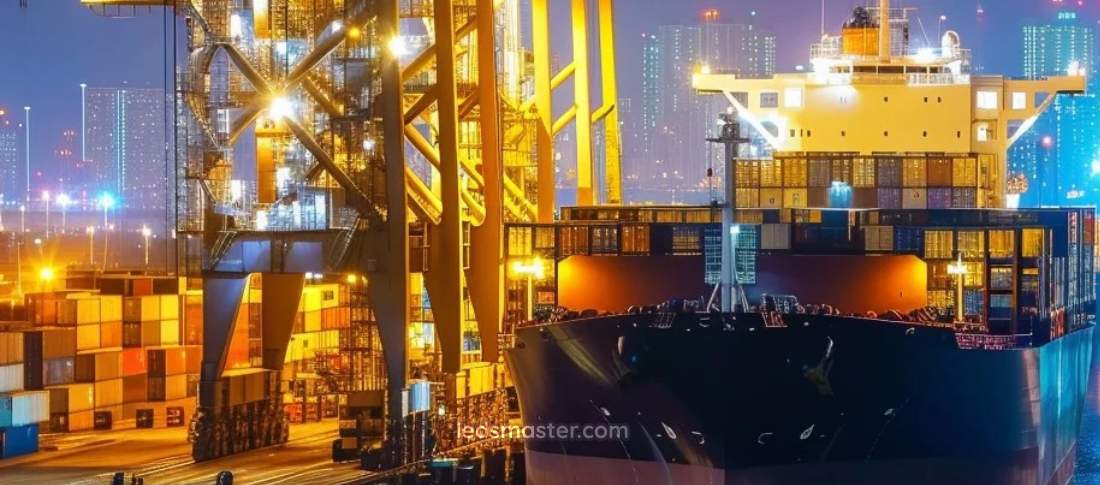Discover durable shipyard lighting solutions, including LED fixtures and corrosion-resistant floodlights, designed for safety and efficiency. Embrace smart technology and renewable energy integration to enhance operations and reduce environmental impact.
One of the primary challenges in shipyard lighting is ensuring fixtures are resistant to sea water, which can quickly corrode standard materials. Therefore, lighting fixtures designed for shipyards must be constructed from marine-grade stainless steel or specially treated aluminum to mitigate corrosion effectively. This sea water proofing not only enhances durability but also reduces maintenance costs and downtime associated with frequent replacements.
Get your complimentary lighting design today
Table of Contents
ToggleGiven the unique demands of shipyard environments, lighting solutions must be strategically designed and implemented to withstand harsh conditions, optimize energy efficiency, and provide consistent illumination across expansive and high-risk areas. Various types of lighting fixtures are deployed across different shipyard zones, each selected for specific performance characteristics that align with the unique requirements of these industrial settings.

High bay LED fixtures are among the most vital lighting solutions for shipyards, providing strong and reliable illumination for large, high-ceilinged spaces. These fixtures are ideal for areas like assembly bays, where workers handle intricate tasks such as shipbuilding and equipment maintenance. The durability and energy efficiency of high bay LEDs make them highly suitable for these demanding workspaces, as they are designed to perform under intense, extended usage while withstanding exposure to environmental stressors.
High bay LEDs are selected for shipyards due to their excellent light output, high luminous efficacy, and robust design, allowing them to illuminate vast areas without requiring excessive energy. Their light output is essential for ensuring that all areas are sufficiently bright, enabling workers to carry out their tasks with precision. Given that shipyards often operate around the clock, the energy efficiency of these LEDs also plays a significant role in reducing operational costs.
The strength of high bay LED fixtures lies not only in their performance but also in their ability to reduce maintenance costs. Unlike traditional lighting options, LEDs have longer lifespans, which means that frequent replacements and repairs are minimized. This longevity is crucial in shipyards where downtime for repairs can impact operational productivity. High bay LED fixtures are used across various shipyard zones, including assembly areas, repair stations, and large storage spaces, contributing to a safer and more efficient environment by minimizing the risk of work-related accidents associated with poor lighting conditions.
Floodlights are another indispensable lighting solution in shipyards, especially for outdoor areas. Coated with materials resistant to seawater corrosion, floodlights ensure optimal visibility during nighttime operations or in dimly lit outdoor spaces. The durability of these fixtures is critical as they are constantly exposed to harsh environmental factors such as sea spray, high winds, and fluctuating temperatures. Floodlights play a pivotal role in illuminating docks, open storage areas, and assembly zones, making them integral to maintaining continuity in shipyard operations.
Floodlights in shipyards are designed to deliver wide-angle light coverage, ensuring that even the most extensive areas are adequately illuminated. This is particularly important in docks where the movement of large machinery, vehicles, and ships takes place. The broad illumination area provided by floodlights minimizes the creation of shadowed zones, which are often safety hazards. The specialized coatings applied to floodlight fixtures not only protect them from corrosive elements but also extend their lifespan, ensuring reliable performance over extended periods.
Beyond basic illumination, modern floodlights offer adjustable intensity and directional controls, allowing operators to target light precisely where it’s most needed. This feature not only optimizes energy use but also prevents excessive glare, which could impede visibility for workers and machinery operators alike. In this way, floodlights contribute significantly to both the safety and operational efficiency of shipyard activities.

The unique challenges of maritime environments make it essential to carefully design and plan shipyard lighting systems. Effective shipyard lighting design involves a thorough understanding of factors such as durability, weather resistance, and the uniformity of light distribution. By addressing these considerations, shipyards can ensure long-lasting, efficient lighting systems that contribute to safer and more productive operations.
Shipyards are typically located in coastal areas, where environmental conditions are often severe. Lighting fixtures in these settings must be resilient against elements such as salty air, high humidity, and extreme temperature fluctuations. The materials and coatings used in shipyard lighting fixtures are therefore chosen for their ability to resist corrosion and damage from these elements. For instance, fixtures with powder-coated finishes or those made from corrosion-resistant materials like stainless steel are preferred in shipyards as they are more resistant to rust and other forms of deterioration.
Effective sealing and enclosure designs are equally important in preventing water ingress, which can lead to electrical malfunctions or even complete lighting failure. Shipyard lighting fixtures are often equipped with IP65 or higher-rated enclosures that ensure no moisture or dust can enter the internal components. This level of protection is critical in preventing frequent maintenance issues, as fixtures can remain operational despite exposure to rain, seawater, or high-pressure wash-downs commonly used in shipyards.
Uniform brightness across the entire shipyard is essential to both safety and operational productivity. Inadequate or uneven lighting can cause accidents, as workers may struggle to see potential hazards, or machinery operators may have difficulty navigating. High bay LED fixtures, with their precise optics and high lumen output, are often deployed strategically to avoid shadows and glare, creating a consistent lighting field that enhances visibility for detailed tasks.
To minimize glare, high bay LEDs are often equipped with diffusers or anti-glare covers, which help to direct light more evenly across the work area. These fixtures can be mounted at strategic angles and heights to avoid casting shadows or creating blinding reflections on surfaces. Additionally, floodlights are positioned to provide wide-area coverage, complementing high bay LEDs by illuminating peripheral zones such as docks and open storage areas. This approach to lighting design ensures comprehensive coverage, reducing potential visibility issues that could hinder workflow and safety.
Proper installation and regular maintenance of shipyard lighting fixtures are essential to ensure their reliability and longevity. Given the harsh conditions in shipyards, lighting systems must be installed and maintained by professionals well-versed in maritime safety standards to avoid premature failure and ensure optimal performance.
Importance of Qualified Installation Teams
The installation of shipyard lighting fixtures should be managed by professionals with expertise in maritime lighting requirements and safety protocols. Qualified installers understand the unique challenges of shipyard environments, such as exposure to corrosive elements and fluctuating weather conditions. They are trained to ensure that fixtures are securely mounted, effectively sealed, and compliant with relevant safety standards, minimizing the risk of accidents or premature equipment failure.
Compliance with Maritime Safety Standards
Qualified professionals also ensure compliance with maritime-specific safety standards, which govern aspects such as fixture placement, wiring, and mounting to withstand external pressures and environmental conditions. By adhering to these regulations, installation teams reduce the likelihood of electrical hazards, equipment malfunctions, and other issues that could jeopardize worker safety and disrupt operations.
Routine inspections are vital for ensuring the continuous performance of shipyard lighting systems. Scheduled inspections allow maintenance teams to identify and address potential issues, such as corrosion or water ingress, before they impact lighting functionality. This proactive approach to maintenance helps to prevent costly repairs or replacements by addressing wear-and-tear early.
Shipyard lighting fixtures are also subject to regular cleaning and testing to maintain their operational efficiency. Dust, salt deposits, and other contaminants can accumulate on fixtures, reducing their light output and potentially impacting the longevity of the materials. Routine cleaning helps to prevent these buildups, ensuring that fixtures maintain their intended brightness and efficacy. Additionally, testing light levels and inspecting electrical connections help ensure that fixtures continue to perform optimally, contributing to overall safety and productivity.
As technological advancements continue to shape the maritime industry, shipyard lighting is evolving with innovations that enhance efficiency, safety, and sustainability. Future trends in shipyard lighting are focused on smart technologies and the integration of renewable energy sources, aligning with broader industry goals for environmental responsibility and cost-effectiveness.
Smart lighting solutions are increasingly being adopted in shipyard environments, offering dynamic lighting control through sensors and automated systems. These smart lighting technologies adjust light levels based on real-time environmental conditions, occupancy, and task-specific requirements. By optimizing energy consumption in response to operational needs, smart lighting solutions reduce operational costs and contribute to sustainability efforts by limiting electricity usage during non-peak hours.
Smart lighting technologies also enhance safety by ensuring that adequate lighting is available exactly when and where it is needed. For instance, sensors detect movement and increase lighting intensity in areas where active work is taking place, thus minimizing the risk of accidents caused by insufficient visibility. Additionally, the ability to control and monitor lighting remotely allows shipyard managers to respond to changing conditions, such as poor weather or nighttime activities, without requiring manual intervention.
A growing trend in shipyard lighting is the integration of renewable energy sources, particularly solar power. By installing solar panels throughout the shipyard premises, shipyards can harness abundant sunlight to generate electricity for lighting needs, reducing reliance on traditional grid power. This approach not only lowers operational costs but also aligns with global environmental sustainability goals, as it decreases the carbon footprint associated with shipyard activities.
The use of renewable energy in shipyard lighting systems contributes to operational resilience by diversifying energy sources. This mitigates the impact of energy price fluctuations and provides shipyards with a reliable backup during power outages. Additionally, renewable energy integration represents a forward-thinking approach that positions shipyards at the forefront of sustainable industrial practices, enhancing their reputation within the global maritime sector.
By prioritizing durability, efficiency, and sustainability through advanced technologies, shipyards can enhance safety, productivity, and operational resilience. Investing in high-quality lighting solutions tailored to the unique challenges of shipyards is essential for supporting the growth and efficiency of the global maritime industry.